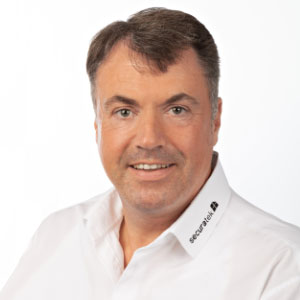In this field report, we show how you can use the Paddock Plates PP60 (compatible with the Anchor Grid AG60) from Securatek to quickly and easily secure a steep access to a pasture on a slope. Initial situation: A particularly steep pasture access on slippery clay soil. Behind the paddock of an open stable for horses, there is a section of pasture on a slope that can be accessed via a narrow and steep path with a gradient of 12 to 15%.
Paddock Plates with Ground Anchor for slopes up to 15%
The ground consists of a clay soil that is quite slippery, especially in rainy weather. Unfortunately, this area is not accessible with heavy equipment. Also the delivery of bulk material is not possible at this place.Accordingly, it should be tried to get along with a minimum substructure.
Paddock Plates laying without substructure
The Paddock Plates PP60 are suitable for our purpose, as they are designed for laying without a substructure. Originally, these slabs were designed for use in vineyards, where they were to fix steep paths between vines for the use of tractors and harvesters. There are wedges on the bottom to grip into the ground to prevent slipping.
Paddock Plates with anti-slip surface or profiling
The surface is profiled and should thus be slip-resistant. The relatively small panels (40 cm x 40 cm) are connected with a flexible peg system. A joined surface can thus adapt to slight changes in the slope of the terrain.
- Weight: 5,63 kg/m²
- Load capacity: 100 t/m²
- Dimensions of single plate: 400 x 400 x 60 mm
- Material: PE-PE
- Wall thickness 3 mm
The panels were delivered on pallets within a few working days by a forwarding company. Thereby 6 plates each were already pre-inserted. For 28 m² pasture access the following materials and menegen were needed:
- 180 Paddock Plates PP60 from Securatek
- approx. 1 ton of Weser sand (grain size 0-8 mm)
- approx. 1 ton of Weser sand (grain size 0-2 mm)
- 1 x vibrating plate
Preparing and creating the substrate for Paddock Plates
The area to be covered was roughly marked out beforehand and largely leveled with a flat shovel. Uneven areas were leveled with coarse Weser sand (0-8 mm) or crushed sand. Approximately half a wheelbarrow (i.e. about 40 l) of sand was used per pre-staked field of 6. Even though such a substrate can still be relatively soft, it is sufficient for the PP60 panels.
Installation the Paddock Plates PP60
Due to the pre-placed elements, the laying went relatively quickly. Only the laying direction had to be observed. Always work in one direction so that there is always a row of holes into which the tenons of the next panel could be inserted from above. The tenons are snapped into place with a strong kick or, somewhat more elegantly, with a rubber mallet. The pre-inserted elements can easily be added to in order to achieve the desired width or to lay other shapes. It is very easy to divide the pre-cut elements and assemble them into new shapes. Since the panels are relatively light, they are also very easy to work with.
When all the slabs were laid, the vibratory plate had to be used to work the slabs into the ground. Once the sand used as a base had vibrated into the voids, the vibratory plate's job is done. Alternatively, a roller can be used. Finally, the remaining voids were filled with finer sand (Weser sand 0-2 mm) and a footing layer was applied. A little distribute and the new pasture entrance can be handed over to the four-legged users. A few days and nights with later: One of the new users of the pasture entrance has rolled himself for the photo extra before in the dirt. The pasture entrance was well received and survived the first nights of heavy rain.
We from Securatek thank our customers and refer to its publication on: Offenstall.org
You are planning a similar project?
You need tips for product selection or installation?
Have you used any of our products?
Then we would be pleased if you upload your reference photos!


















